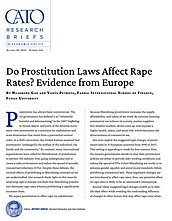Prostitution has always been controversial. The US government has defined it as “inherently harmful and dehumanizing” in the 2007 Trafficking in Persons Report, and parts of the feminist movement view prostitution as a synonym for exploitation and male domination that result from a patriarchal societal order. In a 1949 convention, the United Nations asserted that prostitution “endanger[s] the welfare of the individual, the family and the community.” By contrast, many international organizations have called for liberalization of prostitution to prevent the industry from going underground and to create a safer environment and reduce the spread of sexually transmitted infections (STIs). Despite these debates, the societal effects of prohibiting or liberalizing commercial sex are understudied. Our research sheds light on this issue by analyzing rape in Europe and finds that liberalizing prostitution decreases rape rates whereas prohibiting it significantly increases them.
We expect prostitution to affect rape via substitution because liberalizing prostitution increases the supply, affordability, and safety of sex work. By contrast, banning commercial sex induces its scarcity, pushes suppliers into shadow markets, drives costs up, and imposes a higher health, safety, and social risk, which decreases the attractiveness of commercial sex.
Our tests exploit the staggered legal changes of prostitution laws in 31 European countries from 1990 to 2017. This setting is appealing to study for four reasons. First, the reasons governments decide to alter their prostitution policies are either to provide safer working conditions and reduce the spread of STIs (when liberalizing sex work) or to enhance gender equality and social moral standards (when prohibiting commercial sex). These legislative changes are not introduced to affect rape rates; thus, any potential effect on rape rates is likely to be an unintended consequence.
Second, these staggered legal changes enable us to identify their effect while avoiding the confounding influence of changes in other factors that may affect rape rates when studying a single legal change. Third, during our sample period, eight countries liberalized prostitution while six prohibited it. This allows us to examine both the treatment and the reverse-treatment effects. Last, European judicial definitions of rape are well-harmonized across countries, and rape statistics show high conformity levels, which enables us to better identify the causal effects of commercial sex on rape rates in a cross-country setting.
Our research finds that liberalizing prostitution leads to a significant decrease in rape rates whereas prohibiting it does the opposite. Our research also finds that the effects are asymmetric: the economic magnitude of prohibiting commercial sex is about four times as large as that of liberalizing it. On average, countries that liberalize commercial sex experience a decline in their rape rate by approximately 3 cases per 100,000 people relative to countries that experience no legal changes in prostitution. By contrast, countries that prohibit prostitution experience an increase in their rape rate by approximately 11 cases per 100,000 people relative to countries that experience no legal changes in prostitution. These results are significant given that the sample average rape rate is 9 per 100,000 people.
The key assumption central to a causal interpretation of our results is that the rape rates in all countries in our sample were following similar trends before liberalization or prohibition. We show that this is true and that most of the impact of prostitution laws on rape occurred after the legal change, which suggests a causal effect.
Additionally, considering the well-known fact that rapes are likely to be underreported, our research provides evidence that the effect of prostitution laws on rape rates is stronger when the rape underreporting problem is weaker.
Second, in addition to commercial sex and rape, a third way for men to obtain sex is via marriage or partnership. We show that the effect of prostitution laws on rape rates is more pronounced when it is more difficult for men to obtain sex through these means.
Prostitution policy can be classified into one of the following groups, from the most relaxed to the most restrictive: decriminalization (state tolerance without regulation), legalization (state tolerance with regulation), criminalization (punishing both sex workers and clients), and the Nordic model (punishing only clients). We examine the effects of these different models on rape rates. Our research finds that between the prostitution liberalization models, decriminalization has a stronger effect on reducing rape than legalization, and it finds that between the prostitution prohibition models, the Nordic model has a stronger effect on increasing rape than criminalization. Finally, our research finds that a change in a country’s prostitution laws has no effect on nonsexual crimes (such as homicide, burglary, and robbery). This result indicates that the observed relationship between prostitution laws and rape rates is unlikely due to some confounding legal change that affected a country’s overall criminal activities.
NOTE
This research brief is based on Huasheng Gao and Vanya Petrova, “Do Prostitution Laws Affect Rape Rates? Evidence from Europe,” Journal of Law and Economics 65, no. 4 (2022): 753–89.

This work is licensed under a Creative Commons Attribution-NonCommercial-ShareAlike 4.0 International License.
